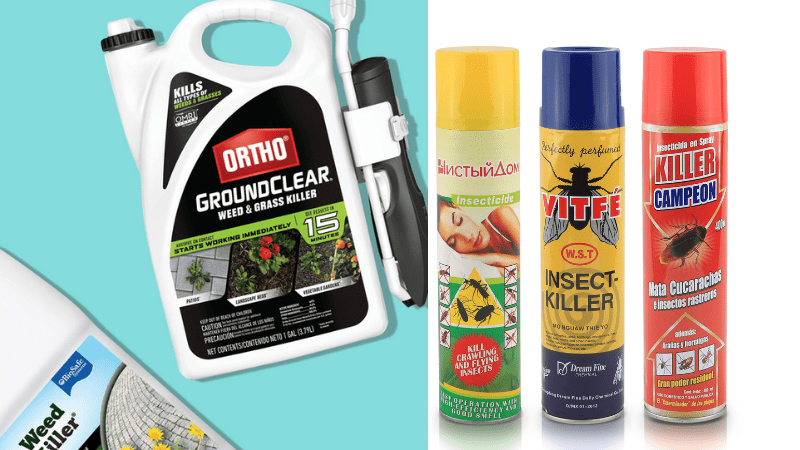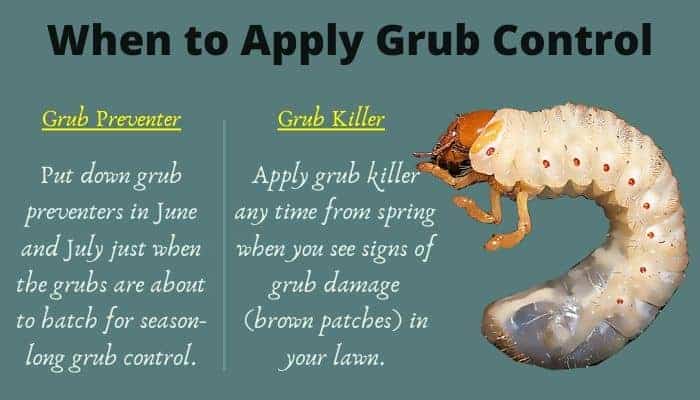Can You Mix Weed Killer And Insecticide? How Do You Mix Pesticides In A Tank?
by Lee Safin
Gardening means you have to deal with harmful or poisonous weeds and insects. Getting rid of them faster is necessary. Otherwise, they will eat up and kill up your beautiful plants. Or they may slow down their growth. We gardeners often use weed killers and insecticides to kill various insects and weeds. Many use both of them together.
So, can you mix weed killer and insecticide?
You can mix weed killer and insecticide together if they have physical and biological compatibility. Additionally, following strict mixing guidance is a must to ensure you don’t harm your plants. Both items are mighty. Mix them carefully. Follow the instruction from the product label.
Let’s learn more about “Can you mix weed killer and insecticide?” to clarify the process.
Contents
- Can You Mix Weed Killer And Insecticide?
- How To Mix Weed Killer and Insecticide?
- Can You Mix Different Pesticides?
- Can You Apply Weed and Feed and Insect Killer at the Same Time?
- How Do You Mix Pesticides In A Tank?
- Can You Mix 2 Herbicides?
- What Is The Usual Order For Tank Mixing Pesticides?
- Fertilizer Vs. Pesticides: What’s The Difference?
- Can Brand Or Generic Herbicides Be Tank-Mixed?
- Can You Fertilize and Use Pesticides at the Same Time?
- Can You Put Down Grub Control And Fertilizer At The Same Time?
- When Mixing or Applying A Pesticide?
- Final Thought

Can You Mix Weed Killer And Insecticide?

Taking care of our plants in the best manner is all we thrive for. But we need to be cautious and remember that our single mistake should not take our beautiful plants’ lives.
Most weed killers and insecticides have chemical-based ingredients (few may have exceptions). These sensitive products may eat up your plants within a short time if you apply them to plants incorrectly.
We know natural solutions are time-consuming, and they often fail to eliminate harmful insects and weeds. As a result, we have no options but to use products like weed killers, insecticides, etc.
If you need to use both weed killer and insecticide together, it is essential to know how to mix them together. Otherwise, you will fail to control or eliminate them, and you may harm plants heavily.
How To Mix Weed Killer and Insecticide?
Here is the procedure you should follow if you wonder, “Can you mix weed killer and insecticide together?”
Before diving into the below-mentioned instruction, make sure you have read the products’ labels carefully. They might have some warning or extra information that you must know.
Step 1 – Add Water Inside The Spray Tank
At first, add water inside the spray tank up to 3 portions out of 4 and switch on the agitation. Let it empty the tank. Keeping a small amount of water is a rule of thumb, as per many garden experts.
Step 2 – pH Adjuster


Then, include pH adjuster additives inside the container.
Step 3 – Include Water-dispersible Granules


Next, you will include water-dispersible granules, which have excellent flowability and decreased risk of dust inhalation. Make you add this dry item sluggishly so that it doesn’t cause any clogged return lines.
Step 4 – Use The Agitator


Before adding the next component, you want to use the agitator for a few minutes.
Step 5 – Stop The Agitator
Then stop the agitator from spraying and mix all components properly. If necessary, shake any liquid-based products using a container before adding them to the tank.
Step 6 – Include Your Preferred Pesticide


Afterward, you will include your preferred pesticides that are easily accessible to you.
Step 7 – Add Liquid Formulation of Emulsifiable Concentrate


Next, you will add a liquid formulation called emulsifiable concentrate, which has better biological activity.
Step 8 – Add a Surfactant


Finally, add a surfactant to decrease the surface tension of the total mixture.
That’s all the procedure you want to follow if you wonder about “Can we mix herbicide and insecticide?”
Can You Mix Different Pesticides?
Sometimes, Yes! Every pesticide features unique properties. Mixing two or more pesticides can be unsafe unless the manufacturer recommends it on the product label. Their chemical or physical conflict of interest may arise after mixing them.
Also, their main functionality might be compromised, or they may act more vigorously than they typically do. In addition, plants might be harmed partially or severely due to the increased toxic.
Can You Apply Weed and Feed and Insect Killer at the Same Time?
Yes, you can apply Weed and Feed, and insect killer simultaneously by following the recommended application rate. You shouldn’t overdo or underdo it. However, their effectiveness may decrease. Hence, they will fail to kill weeds.
How Do You Mix Pesticides In A Tank?

At first, add an adjuvant if necessary to make the whole mixture compatible and stable. After that, close the tank and shake the mix properly. For every ounce of pesticide, add 1 teaspoon to the solution. For instance, if you were planning to apply 5 ounces to the mixture, you would need 5 teaspoons.
Can You Mix 2 Herbicides?
Yes, you can mix two herbicides if there is no restriction to mix them on the product label. But make sure the herbicides you want to use are authentic and registered. Using low-quality and cheap herbicides may harm the plants.
But, high-quality herbicides can be mixed together to control weeds. Study properly to kill a particular type of weeds for the two herbicides you are going to use. Make sure they are compatible.
What Is The Usual Order For Tank Mixing Pesticides?
Are you mixing pesticides in the right order? Here is how you should do it.
- At first, include carrier to the tank ranging between 1/5 to 1/2.
- Then, then add a compatibility agent. It is optional. You can ignore it.
- Next, add a heterogeneous mixture.
- Afterward, add solution products.
- Then, add surfactants. It is optional. Ignore it if it isn’t necessary.
- Finally, add emulsion products.
Fertilizer Vs. Pesticides: What’s The Difference?

Fertilizers work as a nutrition source for plants to ensure proper growth, boost their immune system, and keep them healthy. It works as food for them.
On the other hand, pesticides work as preventers, eliminators, or controllers of various insects, bugs, and fungal diseases. Their job is to keep safe plants from various organisms by killing, preventing, or controlling them.
Can Brand Or Generic Herbicides Be Tank-Mixed?
Yes, you can mix brand or generic herbicides on a specific crop unless it is not prohibited. Using the registered herbicides won’t cause any problem controlling weeds for particular plants.
However, here are some things you should always consider before mixing them.
- Mixing Herbicides in a tank requires you to follow an appropriate sequence and adhere to the maximum effectiveness of the mixture.
- Not all pesticides will be mixed appropriately in the tank. If you are going a pesticide first, test it in a small container to see its compatibility. If it mixtures well, then add it to the tank.
- Every product has different instruction to follow, and you must read it carefully and follow it strictly.
- Since different pesticides are made differently, their use rates will be different. Make sure you know the use rate for each of them and mix them accordingly.
- Some pesticides might be prohibited to mix with other pesticides, and you should avoid mixing them. Generally, manufacturers mention it on the product label. Before you mix two or more pesticides together, research their compatibility. It will ensure success.
Can You Fertilize and Use Pesticides at the Same Time?
Yes, you can. Using fertilizer and pesticides at the same time won’t cause any problem. With the help of a spreader, you can apply pesticide and fertilizer together on your lawn or plants.
Before mixing both ingredients, determine how much pesticide and fertilizer you will need to apply on your lawn or plants. You should follow the manufacturer’s instructions for the use rate per ounce. Finally, mix both of them accordingly.


Pour the mixture on the spreader and set up the rate as per the instruction manual. If there is a difference between pesticide and fertilizer application rates, following the fertilizer rate is okay.
Avoid following the pesticide rate if it has a higher application rate than the fertilizer. It may damage the soil or plants. Follow a crisscrossing pattern to apply on your lawn until all the mixture is finished.
Can You Put Down Grub Control And Fertilizer At The Same Time?

Yes, putting down grub control and fertilizer simultaneously is possible. In fact, there are many readily available mixtures from both items. Mainly, two types of products are available for this mixture: preventative and curative.
The preventative products effectively deal with recently hatched grubs, while curative products can eliminate old grubs that already damaged the plants heavily.
Applying curative products requires you to follow a specific time for the best results. Either you apply from the beginning of September to late October or from March to Mid-May. On the other hand, June to July is the best time for Preventative products, especially if they contain Merit (imidacloprid).
When Mixing or Applying A Pesticide?
There are specific activities you should avoid doing when you want to mix or apply a pesticide. Here are they:
- Don’t smoke or eat when mixing or applying a pesticide because it may contact your hands.
- Never apply more than the recommendation. It may harm the plants.
- Choose an open space area to mix them since they are sensitive products.
- Keep children, pets, and other animals away from the area where you will apply it.
- Wash your cloth several times with detergents if the solution wets your cloth.
- Don’t apply the solution to the plants that are not affected by any insects or weeds.
Final Thought
Here we come to the conclusion part. Hopefully, this post covered “Can you mix weed killer and insecticide?” in greater detail. Take care of your plants properly.
Last update on 2023-01-28 / Affiliate links / Images from Amazon Product Advertising API
 |
 |
 |
 |

About Lee Safin
Lee Safin was born near Sacramento, California on a prune growing farm. His parents were immigrants from Russia who had fled the Bolshevik Revolution. They were determined to give their children a better life than they had known. Education was the key for Lee and his siblings, so they could make their own way in the world. Lee attended five universities, where he studied plant sciences and soil technologies. He also has many years of experience in the U.S. Department of Agriculture as a commercial fertilizer formulator.
Thoughts on "Can You Mix Weed Killer And Insecticide? How Do You Mix Pesticides In A Tank?"
 |
 |
 |
 |
Gardening Stuff
Get FREE Gardening Gifts now. Or latest free toolsets from our best collections.
Disable Ad block to get all the secrets. Once done, hit any button below
 |
 |
 |
 |